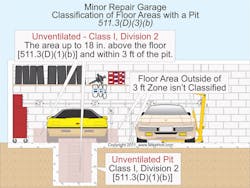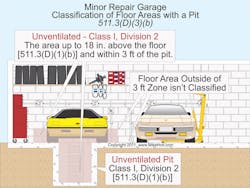Q. In a minor repair garage where flammable liquids won't be dispensed or transferred, what are the classification rules?
A. In minor repair garages, if flammable liquids won't be dispensed or transferred, the classification of (D)(1), (D)(2), and (D)(3) apply [511.3(D)].
1) Floor areas. Floor areas are unclassified, except pit areas are classified as follows:
• The pit area can be unclassified if there's a minimum of four air changes per hour.
• Ventilation not provided: The pit area is classified as Class I, Division 2 up to the floor level.
2) Ceiling areas. The ceiling area is unclassified if natural gas or hydrogen won't be transferred.
3) Pit areas in lubrication or service room. Pit areas must be classified according to (a) or (b).
a) Ventilation provided: The pit area is unclassified if there's a minimum of 1 cfm/sq ft of the floor area at all times that the building is occupied or when vehicles are parked in or over this area.
b) Ventilation not provided: The pit area is classified as Class I, Division 2 up to 18 in. above floor level and extending out 3 ft, as shown in the Figure.
Areas adjacent to classified locations aren't classified if mechanically ventilated at a rate of four or more air changes per hour, or when walls or partitions effectively cut off the adjacent area [511.3(E)(1)].
The storage, handling, or dispensing into motor vehicles of alcohol-based windshield washer fluid in areas used for the service and repair operations of the vehicles doesn't cause such areas to be classified as hazardous (classified) locations [511.3(E)(2)]. Windshield washer fluid isn't flammable.
About the Author

Mike Holt
Mike Holt is the owner of Mike Holt Enterprises (www.MikeHolt.com), one of the largest electrical publishers in the United States. He earned a master's degree in the Business Administration Program (MBA) from the University of Miami. He earned his reputation as a National Electrical Code (NEC) expert by working his way up through the electrical trade. Formally a construction editor for two different trade publications, Mike started his career as an apprentice electrician and eventually became a master electrician, an electrical inspector, a contractor, and an educator. Mike has taught more than 1,000 classes on 30 different electrical-related subjects — ranging from alarm installations to exam preparation and voltage drop calculations. He continues to produce seminars, videos, books, and online training for the trade as well as contribute monthly Code content to EC&M magazine.

